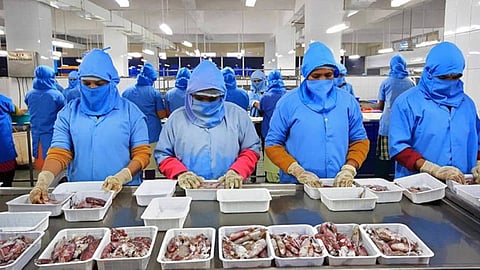Gujarat’s seafood exports face a double whammy
Seafood exports of Gujarat have dwindled by around 15 per cent in the last four months as stringent Covid tests of every container imported from India at major ports in China continue to delay cargo movement.
Over 150 seafood processing units based in Gujarat export about 35 lakh tonnes of seafood worth around Rs5,000 crore every year. Most consignments are transported to the Chinese ports of Shanghai, Tianjin, Guangzhou, etc, from Pipavav in Gujarat. Of the total seafood exports from Gujarat, nearly 65 per cent are sent to China every year. The coastal towns of Veraval and Porbandar are the two major centres of marine trade in Gujarat. Ribbon fish, cuttlefish, croaker fish, squid and shrimps are some of the popular varieties exported from the Saurashtra region of Gujarat.
“It is a crisis-like situation for us, currently. The pace at which each and every seafood container exported by us is subjected to a Covid test at Chinese ports by the local authorities is extremely worrying. Their slow pace of hygiene tests has disrupted and delayed the entire supply chain of seafood processing units in Gujarat,” said Piyush Fofandi, President, Seafood Exporters Association of Gujarat.
It is estimated that Covid infection tests of around 1,000 seafood containers exported from Gujarat are yet to be completed by the local health authorities at Chinese ports, and around 700 seafood containers are currently stocked in the cold storages of processing units in Gujarat.
“Exporters in Gujarat have now got very little space left to stock their export consignments in cold storage. And, it is a double whammy for the fisheries economy in Gujarat as around 1,000 fishing boats in the state are lying idle at about 16 fishing hubs currently due to the unavailability of trained crew members. Most of them have not yet returned from their native state of Andhra Pradesh after pandemic lockdown restrictions were eased in Gujarat,” added Fofandi.
Liquidity crisis
Rakesh Motivaras, promoter of Veraval-based Shyam Marine Foods said: “Over 27 different interior and exterior points of each and every seafood container exported by us are checked for Covid infection by the local health authorities at Chinese ports at a snail’s pace. This process has almost come to standstill since last month. This is why, around 70 per cent of the seafood processing units of Gujarat are facing existential crises as exports to China have stalled.”
“Also, we are facing a severe liquidity crisis at present. It is estimated that seafood exporters in Gujarat are awaiting a cumulative payment worth around Rs1,500 crore towards consignments exported to Chinese buyers since August 2020. It takes around three weeks for the seafood cargo to reach a major port in China from Pipavav. Earlier, Chinese buyers used to send us the payment within a month’s time once our consignments got unloaded at any Chinese port. It’s been four months and we have not yet got the receivables from them as our consignments have got stuck at the major ports in China. It seems that China is deliberately creating a trade barrier for seafood imports into their country,” added Motivaras.
Jawahar Chavda, Minister of Fisheries of Gujarat said: “Gujarat government has taken cognizance of this serious matter and is contemplating a speedy solution to help seafood exporters and also the boat owners through a subsidy scheme. So far, we have not contacted the Chinese Embassy in New Delhi to solve this imbroglio although my secretariat is in constant touch with government officials in New Delhi to address this issue.”
Gujarat’s seafood exports sector provides livelihood to over 3.5 lakh fishermen and they operate around 25,000 fishing boats across the 1,600km-long coastline of the state round the year, barring the monsoon season.
The processed seafood is usually refrigerated inside the export containers at -18 degrees C. Last month, an English-language and state-owned Chinese newspaper ‘Global Times’ published the view of Shanghai-based infectious disease expert and leader of Shanghai Covid-19 control group, Zhang Wenhong, that Coronavirus can maintain a longer vitality in dark and cold environments, especially in wet and cold shipping containers that have landed, which will increase the risk of infection via unprotected contact! The Chinese custom authorities therefore have further enhanced their inspection of cold-chain imported foods in a bid to prevent the risk of imported coronavirus infections.
The Seafood Exporters Association of Gujarat has urged the Government of India to intervene at the diplomatic level and persuade China to relax Covid-19 protocols for Indian seafood shipments at the earliest.

